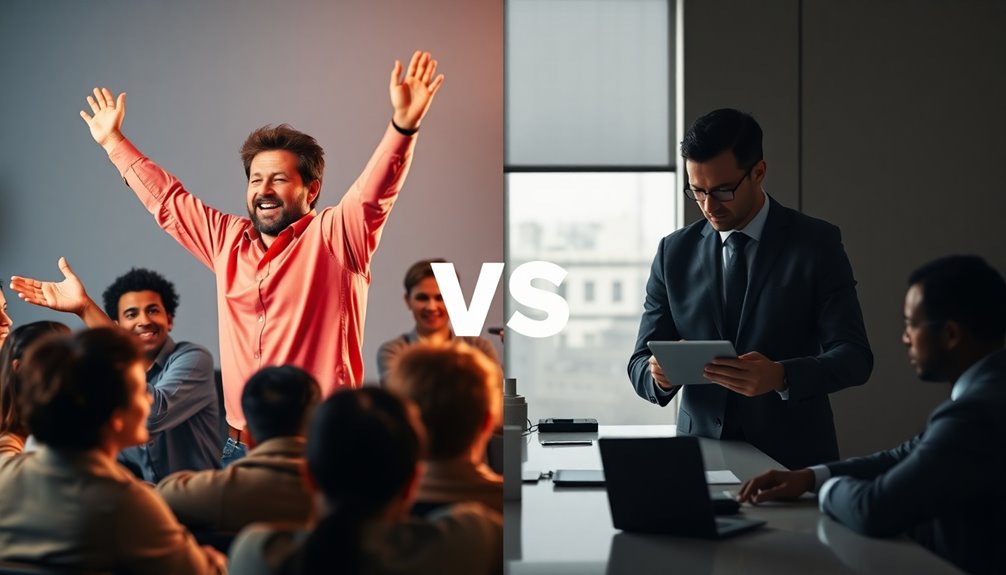When making decisions under uncertainty, behavioral economics teaches you to recognize cognitive biases like confirmation bias, availability heuristic, and optimism bias that can distort your judgment. By becoming aware of these mental shortcuts, you can counteract them with systematic strategies such as considering multiple perspectives, relying on data, and setting clear criteria. This awareness helps you to avoid pitfalls and make more rational choices, ensuring better outcomes even when information is limited—continue exploring to uncover how to master these skills.
Key Takeaways
- Recognizing cognitive biases like confirmation bias and availability heuristic helps improve decision quality under uncertainty.
- Awareness of biases allows for deliberate strategies to counteract their influence during decision-making processes.
- Incorporating multiple perspectives and data-driven analysis reduces reliance on heuristics and emotional judgments.
- Setting predefined risk criteria and questioning assumptions promote more rational and consistent choices.
- Understanding behavioral economics reveals how psychological factors shape risk perception and decision outcomes.

Making decisions under uncertainty is a common challenge that requires balancing risks and potential outcomes when information is incomplete or ambiguous. Your perception of risk plays a pivotal role here, shaping how you evaluate the possible consequences of your choices. But your perception isn’t always objective; cognitive biases often distort your judgment, leading you to overestimate or underestimate certain risks. For example, confirmation bias might cause you to focus only on information that supports your existing beliefs, making you ignore warning signs or alternative options. Similarly, the availability heuristic can lead you to overvalue recent or emotionally charged events, skewing your risk perception and causing you to overreact or underreact to particular threats.
Understanding these biases is essential because they influence your decision-making process more than you realize. When faced with uncertainty, your mind tends to seek patterns or shortcuts to make sense of incomplete data, often relying on heuristics—mental shortcuts that simplify complex problems. While heuristics can be helpful, they also open the door to cognitive biases, which can lead you astray. For instance, the optimism bias might cause you to underestimate the probability of negative outcomes, leading you to take unnecessary risks. Conversely, the pessimism bias can make you overly cautious, preventing you from seizing opportunities that could have been beneficial. Recognizing how your risk perception is shaped by cognitive biases allows you to take a more deliberate approach to decision-making. Instead of reacting instinctively, you can pause and critically evaluate whether your perceptions are skewed by bias. For example, when you notice yourself overestimating a risk because of recent negative news, remind yourself to consider the broader context and statistical data. Conversely, if you’re underestimating a genuine threat, seek additional information or consult others to gain a more balanced view. By actively questioning your assumptions and being aware of common biases, you improve your ability to make more rational choices under uncertainty.
Recognizing biases helps you avoid pitfalls in decision-making under uncertainty.
Behavioral economics shows that decision-making isn’t purely rational; it’s deeply influenced by psychological factors. Recognizing the impact of cognitive biases and how they distort risk perception is an indispensable step toward making better decisions. When you understand these influences, you can develop strategies to counteract them—like considering multiple perspectives, relying on data rather than gut feelings, and setting predefined criteria for risk. Additionally, understanding the role of color accuracy in visual perception can help you better interpret information and make more informed choices. Ultimately, embracing this awareness helps you navigate uncertainty more effectively, making decisions that are less vulnerable to the pitfalls of cognitive biases and more aligned with your true goals and values.
Frequently Asked Questions
How Can Individuals Improve Decision-Making Under Uncertainty?
When facing uncertainty, you can improve your decision-making by recognizing heuristic shortcuts you might rely on, which can lead to biases. Avoid decision fatigue by taking breaks and simplifying choices, helping you stay clear-headed. Break complex decisions into smaller steps, and weigh options carefully. This way, you make more informed choices, reduce errors, and manage uncertainty better, ultimately boosting your confidence and outcomes.
What Role Does Emotion Play in Uncertain Decisions?
Emotions can be a double-edged sword in uncertain decisions, so you need to watch out for emotional bias and the affect heuristic. They often lead you to rely on feelings rather than facts, clouding judgment. When emotions run high, your decision-making might become less rational, making you see risks as either bigger or smaller than they truly are. Staying aware helps you keep a level head when facing uncertainty.
Are There Specific Biases That Dominate Under High Uncertainty?
Under high uncertainty, you often rely on heuristic shortcuts, which can lead to specific biases like overconfidence bias. This bias makes you overestimate your knowledge or abilities, causing you to take risks or ignore warning signs. Recognizing these biases helps you make more informed decisions. When uncertainty is high, being aware of your tendencies toward heuristic shortcuts guarantees you stay cautious and consider alternative perspectives.
How Does Uncertainty Influence Risk Perception?
Uncertainty shapes your risk perception by triggering heuristic biases like overestimating rare events, making risks seem bigger than they are. You tend to avoid ambiguity, preferring known risks over unknown ones, which is called ambiguity aversion. This bias makes you more cautious when faced with uncertain situations, often leading to conservative choices. Recognizing these tendencies helps you better understand your decision-making process under uncertain conditions.
Can Behavioral Economics Insights Be Applied in Real-World Scenarios?
Imagine making everyday choices without realizing how heuristic shortcuts guide you or how social influences sway your decisions. Behavioral economics insights can definitely be applied in real-world scenarios—whether you’re negotiating, investing, or managing risks. These lessons reveal hidden biases, helping you understand and improve your decision-making. By recognizing these influences, you gain an edge, making smarter choices even amid uncertainty. It’s a powerful tool you can’t afford to overlook.
Conclusion
Just as a seasoned sailor navigates stormy seas by trusting both charts and intuition, you can make better decisions under uncertainty by balancing logic with awareness of biases. Remember, the horizon isn’t always clear, but understanding behavioral traps can guide you safely through. Embrace these lessons, and like a lighthouse cutting through fog, your choices will shine with clarity, leading you toward confident, informed actions amid life’s unpredictable waters.








